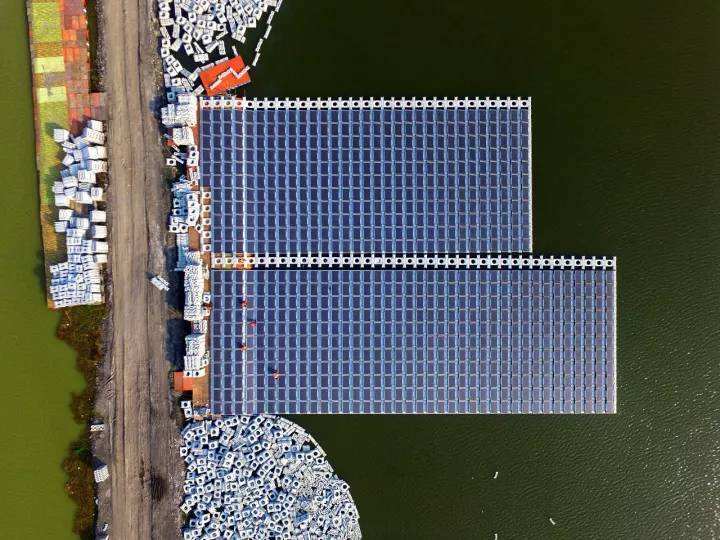Moreover, there are many bright spots of floating photovoltaic power station!
Breeze blows the lake, and the water waves gradually. The rows of solar photovoltaic panels were laid in the middle of the lake, forming a spectacular square array, which absorbed the heat of the sun silently. And the fishes swam around happily in clear water...This was an view saw by a reporter in a coal mining occupied areas in Anhui Province, China. In the past, there were tan wasteland, black coal mines and pot-holed water everywhere.
In fact, electricity is generated by the photovoltaic power stations by using buoys to float photovoltaic modules on the water surface. It has become a hot topic in the past two years. With the large-scale development of photovoltaic in recent two years and the restriction of the nature of land, the land available for the construction of photovoltaic power stations has become increasingly scarce. At the same time, China is rich in water resources and China is one of the countries with many lakes in the world. There are about 20,000 lakes in China, with a total area of about 80,000 square meters. Then, to widen the application of PV power and to develop the pv plants on the water can relieve the land pressure.

For example, the total area of the occupied coal mining area in Huainan and Huaibe cities is about 0.78 million mu, and there is about 0.38 million mu in its water area. A large proportion of the coal mining area is adopted the form of water photovoltaic power generation. There is a 150 MW photovoltaic project has recently formally connected to the grid. The total investment of project is about 1 billion yuan. And the annual output of clean electricity is about 150 million KWH, which can save about 53,000 tons of coal, and reduce about 199500 tons of carbon dioxide emissions. What’ more, it can meet about 94000 urban and rural families’ demands.
The development of floating photovoltaic power stations has obvious advantages, which can not only save land resources, but also improve the efficiency of power generation. Floating photovoltaic power station on the water does not occupy land resources, and water has a cooling effect on photovoltaic modules, which can inhibit the rise of the surface temperature of modules, so as to obtain higher power generation. In addition, solar panels covering the surface of the water can also reduce water evaporation, inhibit algae growth and protect water resources.
However, floating photovoltaic projects have high requirements for equipment selection. The floating body shall have good corrosion resistance, low density, anti-frost heaving, anti-wind and anti-waves, long service life and bearing capacity. Despite it relies on floating devices to support photovoltaic panels, the overall environment for floating photovoltaic power stations still remains humid. Therefore, the selection of mounting structures of photovoltaic power stations on the water is also strict.
Due to the humid environment, anti-corrosion property should be put in the first place in the selection of mounting structures. So, the main material of mounting systems is aluminum, and the standard parts are stainless steel. Secondly, the strength design of the mounting structure are needed to consider.
In addition, because the photovoltaic mounting systems are customized products, the application environment should be also paid attention to. The floating mounting system is the best only by the combination of the photovoltaic application environment. For example, considering that there is no fixed foundation for PV on the water, floating objects need to float up and down in a large rang.
Compared with Japan, India, South Korea, Singapore, the United Kingdom, Norway and other countries, they have mature applications of floating photovoltaic power stations. China started this technology relatively late, and the floating photovoltaic project on the water is still in the demonstration stage, which is still far from large-scale development.
However, the floating photovoltaic mounting structures has been improved several times and is now more and more mature, but there is still room for improvement.
